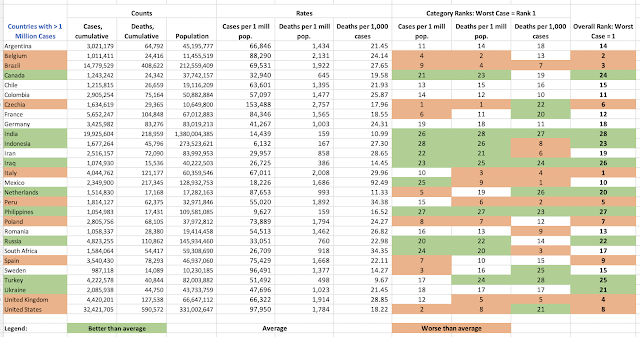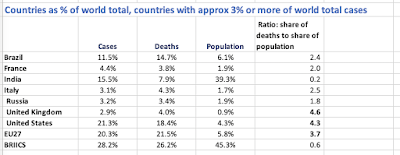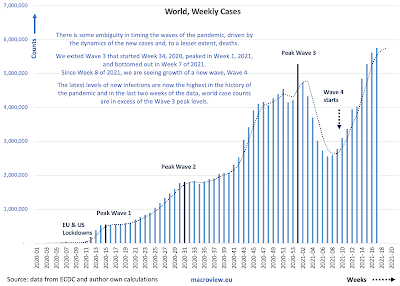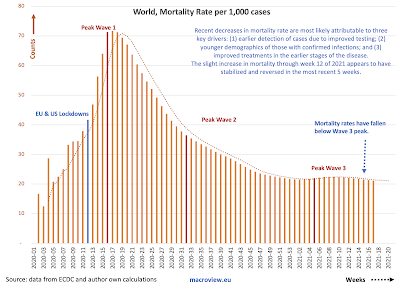Updating data for the U.S. - EU27 comparatives for the pandemic through this week (week 17):
- Firstly, total number of new cases has diverged in recent weeks. Starting with week 7 of 2021, the U.S. cases continued to fall, while the EU27 cases entered a new upward trend. The new wave - Wave 3 - formed in Europe, whilst the U.S. managed to escape development of Wave 4.
- For eleven of the last consecutive weeks, the EU27 cases significantly exceeded those in the U.S.
- As of Week 12, 2021: EU27's Wave 3 has peaked and we have now witnessed five continuous weeks of declines from the peak, although the EU27 case numbers still substantially exceed those in the U.S.
- There is only one attributable difference between the two countries that can explain this divergence: vaccinations rates. In fact, whilst the U.S. response to the pandemic in its first 10 months has been an unmitigated disaster, the EU27's unroll of the vaccines has been a Trumpesque-level failure of its own.
- The EU27 started 2021 with a significantly lower per-capita death rate than the U.S.
- At the start of January, as reported on this blog, adjusting for age differences and population size differences, the U.S. pandemic was associated with 139,188 excess deaths compared to the EU27.
- At the end of this week, this gap was down to 87,598.
- Put differently, President Trump's policies were responsible for excess deaths amounting to roughly 1/3 of the total deaths sustained in the U.S. over the period of 2020. Since the start of 2021, EU27 policies on vaccinations are responsible for closing this gap by almost 40 percent.
- The above comparatives for vaccination roll out failure effects are conservative. The EU27 has suffered Wave 3 of the pandemic amidst strict and wide-ranging lockdowns, not comparable to the U.S. measures deployed over the same period of time.
- In fact, Week 17/2021 U.S. deaths counts are now lowest for any week since week 27/2020. In contrast, the Eu27 deaths are currently the lowest since week 45/2020.
In fact, as the chart above illustrates, EU27 is yet to see the return to its lowest recorded mortality rate of 0.014 set in Week 37/2020, while the U.S. has been running below that rate on-trend over the last five weeks.
In summary, therefore, the EU27 is paying a high price for its utter failure to unroll vaccinations at scale. The U.S. performance, starting with February-March, has been exemplary compared to the European policy approach, although a lot of the gains made so far are:
- Subject to forward uncertainty (U.S. weekly statistics have been exceptionally volatile and hard to interpret); and
- As of yet, not enough to erase the scars left by the Trump Administration's mismanagement of the early stages of the pandemic.





























